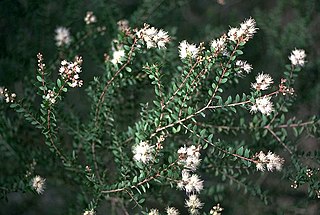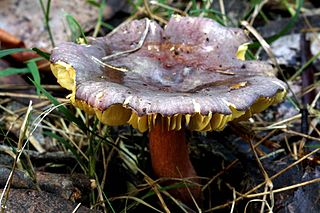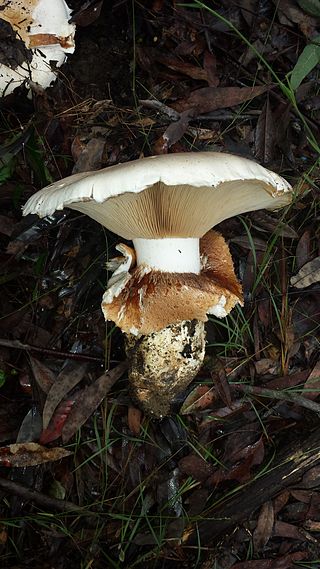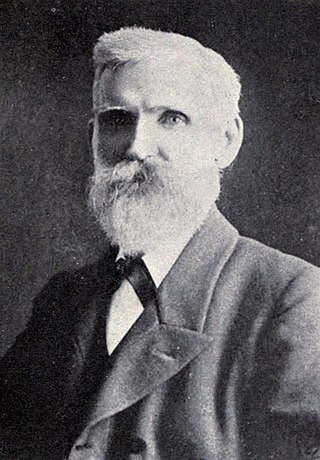Index Fungorum is an international project to index all formal names in the fungus kingdom. As of 2015 the project is based at the Royal Botanic Gardens, Kew, one of three partners along with Landcare Research and the Institute of Microbiology, Chinese Academy of Sciences.

Omphalotus nidiformis, or ghost fungus, is a gilled basidiomycete mushroom most notable for its bioluminescent properties. It is known to be found primarily in southern Australia and Tasmania, but was reported from India in 2012 and 2018. The fan or funnel shaped fruit bodies are up to 30 cm (12 in) across, with cream-coloured caps overlain with shades of orange, brown, purple, or bluish-black. The white or cream gills run down the length of the stipe, which is up to 8 cm (3 in) long and tapers in thickness to the base. The fungus is both saprotrophic and parasitic, and its fruit bodies are generally found growing in overlapping clusters on a wide variety of dead or dying trees.

Cortinarius rotundisporus, also known as the elegant blue webcap, is a basidiomycete mushroom of the genus Cortinarius found in southern Australia, where it is found in eucalypt forests and rainforests. The cap of the fruit body is a steely blue colour, with a yellowish boss, and paler similarly coloured stipe.

Pholiota communis is a species of fungus in the family Strophariaceae. It is found in Southeastern Australia. The small brown mushrooms appear in leaf litter of pines and eucalypts in autumn and winter.

Russula persanguinea is a species of agaric fungus in the family Russulaceae. Described as new to science by John Burton Cleland in 1933, it is found in Australia, where it grows singly or in small groups on the ground in eucalypt forests and woodlands. It resembles the common Northern Hemisphere species Russula emetica.
Russula erumpens is a species of fungus in the family Russulaceae. It is found in Australia, where it occurs in eucalypt forests and woodlands.
Melanoleuca abutyracea is a species of fungus in the family Pluteaceae. Found in Australia, it was first described scientifically in 1931 by John Burton Cleland as a species of Collybia. Mycologist Cheryl Grgurinovic transferred it to Melanoleuca in 2002.

Melaleuca cheelii is a plant in the myrtle family, Myrtaceae and is endemic to the Wide Bay–Burnett region of Queensland. It is a shrub or tree to 10 m (33 ft) with white flowers and papery bark. It has been classified as "near threatened" by the government of Queensland.

Tubaria rufofulva is a species of agaric fungus in the family Tubariaceae. Found in Australia, it was originally described in 1927 by John Burton Cleland as a species of Pholiota. The fungus was transferred to the genus Tubaria in 1983.

Russula clelandii is a species of fungus in the family Russulaceae. Found in Australia, it was described as new to science in 1987. The fungus fruits on the ground in mixed woodlands of jarrah and karri (E. diversicolor), plants with which it is suspected of forming ectomycorrhizae. Fruitbodies are similar in morphology to the North American species Russula mariae. The specific epithet honours Australian naturalist John Burton Cleland.

Austrocortinarius australiensis, commonly known as the skirt webcap, is a species of mushroom in the family Cortinariaceae which is native to Australia and New Zealand. The white mushrooms appear in autumn and can grow very large, with their caps reaching 30 cm (12 in) in diameter.
Clitocybe paraditopa is a fungus of the genus Clitocybe. Found in Australia, it was described in 1919 by naturalists John Burton Cleland and Edwin Cheel. Fruitbodies of the fungus smell strongly of blossoms of the golden wattle and sweet wattle. From the original description of specimens that had been found in New South Wales and South Australia, the describers suggested that it was similar in appearance to Clitocybe subditopa and thus could be called paraditopa, "comparable to [C.] ditopa".

Cortinarius erythraeus, sometimes known as the Jammie Dodger, is a basidiomycete fungus of the genus Cortinarius native to Australia.
Hygrophoropsis psammophila is a species of fungus in the family Hygrophoropsidaceae. Originally described by John Burton Cleland in 1933 as Paxillus psammophilus, it was transferred to the genus Hygrophoropsis by Cheryl Grgurinovic in 1997. It is found in Australia, where it grows in groups in sand.

Phlegmacium lavendulense is a species of fungus in the family Cortinariaceae.

Cortinarius sublargus is a species of fungus in the family Cortinariaceae native to Australia. It was described in 1928 by John Burton Cleland from the Mount Lofty Ranges. Cleland also described Cortinarius radicatus in 1933 from material collected in Willunga Hill, Waitpinga, Mount Lofty, Mount Compass, and Kinchina, Though Cleland regarded them as distinct, later authorities determined them to be the same species. The latter name turned out to be a homonym, having already been given to a different species.

Mycena albidocapillaris is a species of mushroom in the family Mycenaceae that is found in Australia. It was first described scientifically in 1933 by mycologist John Burton Cleland, who named it Mycena subcapillaris. The type collection was made in 1922 on Mount Lofty. It was later discovered that the name was invalid, as Paul Hennings use of that name in 1899 took precedence. Cheryl Grgurinovic and Tom May republished the species with the new replacement name Mycena albidocapillaris in 1997.

Acacia cheelii, commonly known as motherumbah or motherumbung, is a tree belonging to the genus Acacia and the subgenus Juliflorae that is native to eastern Australia.

Daniel McAlpine was a Scottish-born Australian mycologist known for his research in plant pathology. He wrote several publications on plant disease in many crops and other plants. McAlpine was a lecturer in biology at the University of Melbourne from 1884, and, with his appointment to the Victorian Department of Agriculture from 1890 to 1911, became the British Empire's first professional plant pathologist.
Austrocortinarius is a genus of fungi in the family Cortinariaceae.














